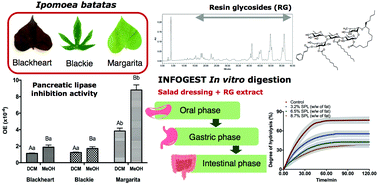Resin glycosides in aerial parts of Ipomoea batatas are potent lipase inhibitors: potential upcycling of sweet potato by-products to combat obesity†
Abstract
Sweet potato (Ipomoea batatas) is a staple food crop that is cultivated globally. While the tubers are widely utilised in the food industry, 95–98% of sweet potato leaves (SPL) are disposed during harvesting. Hence, there is great potential to convert SPL into high-value food products through various processing techniques. In this regard, different varieties of Ipomoea batatas (Blackie, Blackheart, and Margarita) that were grown in Singapore were tested for their pancreatic lipase (PL) inhibitory activity using a high-throughput screening assay. Among them, the Margarita variety showed the highest PL inhibitory activity with an Orlistat Equivalent (OE) value of 3.83 ± 0.36 × 10−4. The kinetic study of the Margarita extract revealed a non-competitive inhibition mechanism. Overall, a series of resin glycosides (RG), responsible for the PL inhibitory activity, was characterised in Margarita Ipomoea batatas. To evaluate the effectiveness of RG under gastrointestinal conditions with high-fat food, in vitro digestion with salad dressing was performed. The in vitro digestion model showed that the consumption of RG with salad dressing was effective in delaying enzymatic fat digestion in a dose-dependent manner. The findings strongly suggested that the aerial parts of Ipomoea batatas have great potential to be upcycled into functional food to combat obesity.



 Please wait while we load your content...
Please wait while we load your content...